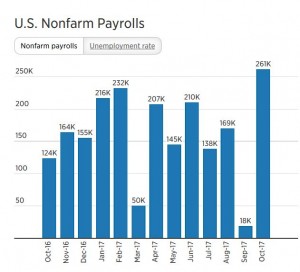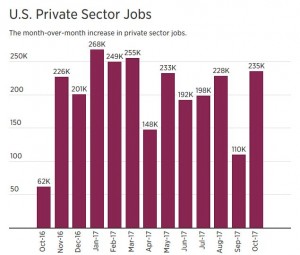BOOM!!! 250,000 JOBS in OCTOBER, Far better than Expectations!!! 3% Wage Gain, FIRST TIME Since Recession!!! LOWEST Unemployment for Hispanics in History!!!
AMERICA … PRESIDENT TRUMP AND GOP CONGRESS MAKING AMERICA GREAT AGAIN!!!
Just ahead of the 2018 midterm elections we are presented with tremendous jobs news … 250,000 jobs were created in October and there was a 3% wage gain, the first time since the recession. The 250,000 jobs created smashed the 190,000 expectation. Over the past 12 months, job gains have averaged a solid 211,000. In a time where many economists have said we are fully employed, Trump and the GOP are creating even more jobs. From CNS News, 156,562,000: Record Employment for 12th Time Under Trump!!!
The unemployment rate held at 3.7 percent, the same as September, which is the lowest it’s been in decades — since the end of 1969. And the Hispanic unemployment rate, 4.4 percent, has never been lower. The unemployment rate for African-Americans, 6.2 percent, remained near the all-time low of 5.9 percent set in May.
AMERICA, WHY WOULD YOU RUIN A GOOD THING AND CHANGE THIS? WHY WOULD YOU PUT DEMOCRATS IN POWER? CAN YOU NOT STAND PROSPERITY?
- Nonfarm payrolls increased by 250,000 for October, well ahead of Refinitiv estimates of 190,000.
- Average hourly earnings increased by 5 cents an hour for the month and 83 cents year-over-year, representing a 3.1 percent gain, the best pace since 2009.
- The unemployment rate stayed at 3.7 percent, the lowest since December 1969.
Job growth blew past expectations in October and year-over-year wage gains jumped past 3 percent for the first time since the Great Recession, the Labor Department reported Friday.
Nonfarm payrolls powered up by 250,000 for the month, well ahead of Refinitiv estimates of 190,000. The unemployment rate stayed at 3.7 percent, the lowest since December 1969.
“The job market is doing remarkably well, particularly this late in the expansion,” said Jim Baird, partner and chief investment officer for Plante Moran Financial Advisors. “This report adds yet another data point to a narrative that has been positive for the labor market this year. Little seems to stand in the way of the economy finishing 2018 out on solid footing.”
The ranks of the employed rose to a fresh record 156.6 million and the employment-to-population ratio increased to 60.6 percent, the highest level since December 2008, according to the department’s household survey. That headline jobless number stayed level even amid a two-tenths of a percentage point rise in the labor force participation rate to 62.9 percent.
Those counted as outside the labor force tumbled by 487,000 to 95.9 million.
But the bigger story may be wage growth, which has been the missing piece of the economic recovery. Average hourly earnings increased by 5 cents an hour for the month and 83 cents year over year, representing a 3.1 percent gain. The annual increase in wages was the best since 2009.
Health care showed some of the biggest gains for the month, adding 36,000. Manufacturing contributed 32,000, thanks to a gain in durable goods and in particular transportation equipment, which added 10,000.
Construction also rose sharply, with an increase of 30,000 while transportation and warehousing jumped by 42,000.
In addition, leisure and hospitality was a strong contributor, with 42,000 new positions after being unchanged in September, due likely to Hurricane Florence, the government report said.
Professional and business services increased by 35,000, bringing its 12-month total gain to 516,000, and mining added 5,000.
Posted November 2, 2018 by Scared Monkeys Economy, Jobs, Labor Force, PT/FT Jobs, Republican, Unemployment | no comments |
Socialist Bernie Sanders Announces Federal Jobs Proposal for All with Healthcare and $15/hr Minimum
JUST LIKE A SOCIALIST … PROPOSES IGNORANT SOCIALIST JOBS PROGRAM WHEN 14 STATES HAVE RECORDED RECORD ALL-TIME LOW UNEMPLOYMENT RATES …
As reported at The Hill, socialist Sen. Bernie Sanders of The People’s Republic of Vermont has announced a federal jobs proposal that would guarantee a job with at least a $15-per-hour wage and health benefits to every adult American “who wants or needs one.” UNREAL, just how would we pay for this socialist program? NOW? Jobs under the Trump administration are being created hand over fist. Capitalism seems to be working just fine. Fourteen states have recorded record low unemployment in the past year which begs the question, why would individuals need the government for a job, except to be kept dependent? If Americans want to work, they just need apply. But what else would one expect from a socialist but making individuals dependent upon government.
The senator is still in the early stages of crafting the plan, according to the Post, which would provide a job or required training for any American.
Sanders’s office has yet to release the details of the plan’s funding, but previous large-scale projects proposed by the Vermont progressive have involved ending tax breaks for the wealthiest Americans and large corporations.
The Vermont senator joins two other possible 2020 contenders, Sens. Kirsten Gillibrand (D-N.Y.) and Cory Booker (D-N.J.), who have also expressed support for similar proposals in recent weeks.
“The goal is to eliminate working poverty and involuntary unemployment altogether,” Darrick Hamilton, an economist at The New School, told the Post.
Maybe Bernie and his socialist friends might want to take a look at the failed Finland experiment … Finland’s basic income trial falls flat. This is what socialism looks like, failure.
The Finnish government has decided not to expand a limited trial in paying people a basic income, which has drawn much international interest.
Currently 2,000 unemployed Finns are receiving a flat monthly payment of €560 (£490; $685) as basic income.
“The eagerness of the government is evaporating. They rejected extra funding [for it],” said Olli Kangas, one of the experiment’s designers.
Some see basic income as a way to get unemployed people into temporary jobs.
The argument is that, if paid universally, basic income would provide a guaranteed safety net. That would help to address insecurities associated with the “gig” economy, where workers do not have staff contracts.
Supporters say basic income would boost mobility in the labour market as people would still have an income between jobs.
Finland’s two-year pilot scheme started in January 2017, making it the first European country to test an unconditional basic income. The 2,000 participants – all unemployed – were chosen randomly.
But it will not be extended after this year, as the government is now examining other schemes for reforming the Finnish social security system.
Posted April 25, 2018 by Scared Monkeys Bernie Sanders (I-VT), Economy, Jobs, Labor Force, PT/FT Jobs, Redistribution of wealth, Senate, Socialism, WTF | one comment |
BLS: Increased by 148,000 in December 2017 … Unemployment Rate Stays at 4.1%
From the U.S. Bureau of Labor Statistics, total nonfarm payroll employment rose by 148,000 in December. Job gains occurred in healthcare, construction, and manufacturing. Although the number of jobs were lower than expected, the underlying numbers are good. The lower amount can be attributed to retail, as this is the day of the internet and on-line shopping, analysts will have to account for that in the future.
In December, the unemployment rate was 4.1 percent for the third consecutive month. The number of unemployed persons, at 6.6 million, was essentially unchanged over the month. Over the year, the unemployment rate and the number of unemployed persons were down by 0.6 percentage point and 926,000, respectively. (See table A-1.)
Among the major worker groups, the unemployment rate for teenagers declined to 13.6 percent in December, offsetting an increase in November. In December, the unemployment rates for adult men (3.8 percent), adult women (3.7 percent), Whites (3.7 percent), Blacks (6.8 percent), Asians (2.5 percent), and Hispanics (4.9 percent) showed little or no change. (See tables A-1, A-2, and A-3.)
Among the unemployed, the number of new entrants decreased by 116,000 in December. New entrants are unemployed persons who never previously worked. (See table A-11.)
The number of long-term unemployed (those jobless for 27 weeks or more) was little changed at 1.5 million in December and accounted for 22.9 percent of the unemployed. Over the year, the number of long-term unemployed declined by 354,000. (See table A-12.)
The labor force participation rate, at 62.7 percent, was unchanged over the month and over the year. The employment-population ratio was unchanged at 60.1 percent in December but was up by 0.3 percentage point over the year. (See table A-1.)
So which business sectors fared well?
Total nonfarm payroll employment rose by 148,000 in December. Job gains occurred in healthcare, construction, and manufacturing. Employment in health care increased by 31,000 in December. Employment continued to trend up in ambulatory health care services (+15,000) and hospitals (+12,000). Health care added 300,000 jobs in 2017, compared with a gain of 379,000 jobs in 2016.
Construction added 30,000 jobs in December, with most of the increase among specialty trade contractors (+24,000). In 2017, construction employment increased by 210,000, compared with a gain of 155,000 in 2016.
In December, manufacturing employment rose by 25,000, largely reflecting a gain in durable goods industries (+21,000). Manufacturing added 196,000 jobs in 2017, following little net change in 2016 (-16,000).
Employment in food services and drinking places changed little in December (+25,000). Over the year, the industry added 249,000 jobs, about in line with an increase of 276,000 in 2016.
Posted January 5, 2018 by Scared Monkeys Jobs, Labor Force, Main, PT/FT Jobs, Unemployment | no comments |
U.S. Economy Ddded 261,000 Jobs in October & Unemployment Rate at 4.1% (Update: Adjusted 92,000 Jobs Added in Aug & Sep)
PUTTING AMERICA BACK TO WORK AGAIN …
More strong jobs numbers have been reported for October 2017 as 261,000 jobs were added. Compare the job growth with what was going on in 2016. Add this to the GDP at 3% and we have an economy finally headed in the right direction.
Total nonfarm payroll employment rose by 261,000 in October, and the unemployment rate edged down to 4.1 percent, the U.S. Bureau of Labor Statistics reported today. Employment in food services and drinking places increased sharply, mostly offsetting a decline in September that largely reflected the impact of Hurricanes Irma and Harvey. In October, job gains also occurred in professional and business services, manufacturing, and health care.
The number of persons employed part time for economic reasons (sometimes referred to as involuntary part-time workers) declined by 369,000 to 4.8 million in October. These individuals, who would have preferred full-time employment, were working part time because their hours had been cut back or because they were unable to find full time jobs. Over the past 12 months, the number of involuntary part-time workers has decreased by 1.1 million.
U.S. economy adds 261,000 jobs in October from CNBC.
The U.S. economy added 261,000 jobs in October and the unemployment rate was 4.1 percent as labor conditions returned to normal following the storm-weakened September.
However, the number was considerably below Wall Street expectations of 310,000. The tick lower in the unemployment rate came against expectations it would hold steady at 4.2 percent.
In addition to the October growth, an initially reported decline of 33,000 for September was revised up to 18,000. August’s count also was revised up from 169,000 to 208,000.
Indeed, the biggest gain in employment came from the hospitality industry, with jobs at food and drinking establishments up by 89,000, reflecting a storm-related rebound. Professional and business services contributed 50,000 to the total while manufacturing added 24,000 and health care increased by 22,000.
In all, employment in the manufacturing sector has increased by 156,000 since President Donald Trump’s election in November 2016. Trump has made blue-collar growth a priority of his economic agenda.
Posted November 3, 2017 by Scared Monkeys Donald Trump, Donald Trump, Donald Trump - Mike Pence 2016, Economy, GDP, Jobs, Labor Force, Main, Making America Great Again, PT/FT Jobs, Unemployment | no comments |
ECONOMY BOOMING UNDER TRUMP … ADP: US Private Sector Jobs Soar … 235,000 Jobs Added in October 2017 vs 200,000 Expected & Worker Productivity Up & Manufacturing Surges in Midwest States
MAKING AMERICA GREAT AGAIN … PUTTING AMERICA BACK TO WORK AND OFF UNEMPLOYMENT.
As reported at CNBC, the number of private-sector jobs created in October 2017 rose to 235,000. That was more than expected and far more than October 2016. In terms of business size, job gains were spread evenly, with companies that have more than 500 employees hiring 90,000 while those with fewer than 50 added 79,000. Mark Zandi, chief economist of Moody’s Analytics, stated that “the job market has rebounded quickly following the devastating hit it took from Hurricanes Harvey and Irma.”
This is one of the many reasons why Donald Trump defeated Hillary Clinton. Trump had a plan for the economy, Hillary did not. The economy is booming in states like Minnesota and Iowa. The coal industry is making a come back. All this country needs is a real and legitimate tax relief plan for business and individuals, not just a tax shell game of moving taxes and it will light this already robust economy on fire.
The number of private-sector jobs created in October rose more than expected, with construction jobs surging in the wake of destructive hurricanes Harvey and Irma.
The ADP National Employment showed private-sector businesses added 235,000 jobs in the month. ADP was expected to show private employers added 200,000 jobs in October, up from 135,000 in September.
ADP October payrolls up 235K from CNBC.
Goods-producing companies benefited strongly with 85,000 new jobs, 62,000 of which came from construction. Manufacturing also saw 22,000 positions added.
Overall, the service sector accounted for the bulk of the job creation, adding 150,000 jobs. Professional and business services added the most positions, up 109,000. Job losses were seen in the trade, transportation, and information sectors, as well as education.
UPDATE I: Preliminary Q3 worker productivity rose 3.0%, vs 2.4% increase expected.
UPDATE II: Manufacturing surges in Midwestern states.
Citing strong exports, hiring and faster ingredient deliveries, Midwest manufacturers reported their highest growth in four months in October, according to a widely watched economic report issued Wednesday by Creighton University.
Creighton’s Mid-America Business Conditions Index, which covers Minnesota and eight other central states, rose to 58.8 in October from 58.2 in September. It is the 11th consecutive month the index signaled strong economic growth for factories in the region.
Minnesota’s index fell to a still strong 56.3 in October from 59.4 in September as factories reported growth across nearly all measures. Any index above 50 indicates growth.
“Over the past 12 months, Minnesota expanded both durable and nondurable goods manufacturing. Gains were strong for food processors and medical equipment manufacturers,” said Ernie Goss, director of the Creighton Economic Forecasting Group.
For the nine-state region — Minnesota, the Dakotas, Iowa, Kansas, Missouri, Nebraska, Oklahoma and Arkansas — Goss found that factory employment, exports, inventories and confidence levels swelled significantly last month while new orders and sales remained strong.
Posted November 2, 2017 by Scared Monkeys Donald Trump, Donald Trump, Economy, Jobs, Labor Force, Making America Great Again, PT/FT Jobs | one comment |

 RSS
RSS











